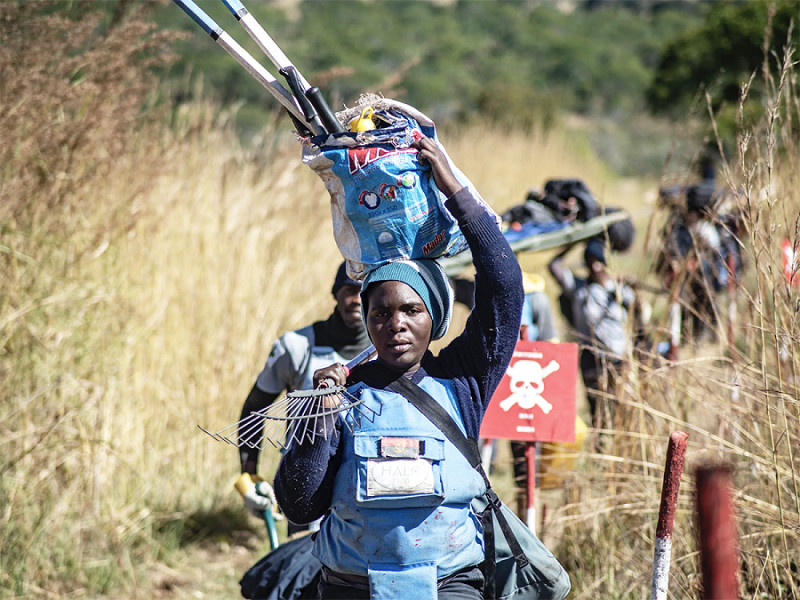Le eroiche sapadora angolane
- Indice dei contenuti
- Brave women in Angola work to clear the fields from mines
La guerra è un male che affligge l’umanità e i suoi effetti rimangono evidenti per secoli e sono intergenerazionali: si perdono vite umane, le economie si esauriscono, le persone vengono sfollate, il trauma coinvolge tutti. Si dice spesso che il tempo guarisce tutte le ferite, ma non è così in tutti i casi.
L’Angola è il ventiquattresimo Paese più grande del mondo, vanta una grande ricchezza di minerali ed è conosciuto come il “Kuwait dell’Africa” per la sua abbondanza di petrolio. Tuttavia, il Paese è stato paralizzato da decenni di guerra civile durata dal 1975 al 2002. La guerra è iniziata a seguito di un effetto a catena dopo un riuscito colpo di Stato militare in Portogallo nel 1974, quando l’Angola non aveva ancora ottenuto l’indipendenza. Tre principali movimenti militari hanno combattuto per l’indipendenza dell’Angola sin dagli anni ‘60, uno dei quali era alleato degli Stati Uniti.
Dopo il colpo di Stato, questi tre movimenti si incontrarono con i rappresentanti del nuovo Governo portoghese nel gennaio 1975 e firmarono l’Accordo di Alvor che garantiva l’indipendenza dell’Angola e prevedeva un Governo di condivisione del potere tra le parti.
Tuttavia, l’accordo durò poco e presto iniziò una sanguinosa guerra civile. Il colpo di Stato aveva precedentemente portato a una competizione della guerra fredda tra gli Stati Uniti e l’Unione Sovietica, causando tensioni nelle relazioni tra i Paesi stessi, e facendo dell’Angola un terreno di scontro tra le grandi potenze, che prestavano appoggio alle varie parti belligeranti.
Nel 2002 la guerra è finita.
Gli effetti della guerra civile sono ancora lì. I cittadini angolani affrontano infatti ancora la minaccia della morte istantanea a causa di una miriade di mine antiuomo lasciate da anni di combattimenti. Le mine terrestri vengono utilizzate per rallentare un esercito invasore nel caso in cui decidano di effettuare un assalto attraverso un terreno scarsamente abitato. I campi minati sono difficili da identificare poiché spesso non sono contrassegnati o non mappati poiché ciò vanificherebbe il loro scopo.
A livello globale, gli effetti delle mine antiuomo sono stati ampiamente osservati nell’Africa sub-sahariana, in Cambogia, in Vietnam e durante la guerra Iran-Iraq.
Le mine antiuomo in Angola esistono a milioni e ogni passo di una persona può portare alla sua morte. Secondo l’unica indagine condotta nel Paese nel 2014, oltre 88.000 persone sono state ferite dalle mine antiuomo, ma la Campagna internazionale per vietare le mine terrestri ritiene che il vero il bilancio potrebbe essere più alto, poiché non esiste un monitoraggio ufficiale in corso delle vittime e la maggior parte delle vittime sono bambini.
In questo contesto si evidenziano le donne in Angola conosciute come “sapadoras” (che significa “sminatrici”) che - attraverso l’HALO Trust e Mines Advisory Group (Mag), una Ong costituita nel 1989 per sovrintendere alla distruzione delle mine antiuomo - rischiano quotidianamente la vita per eliminare le mine antiuomo.
Attraverso un progetto avviato nel 2017, la Ong forma e impiega squadre di sminamento tutte al femminile, creando uno spazio per l’emancipazione delle donne mentre si eliminano le mine terrestri e si rende sicura la terra. Entro il 2021, il progetto aveva reclutato 100 donne. Il progetto fornisce alle donne altre competenze come la manutenzione dei veicoli e la meccanica, il pronto soccorso paramedico e la leadership.
Le donne costituiscono il 40% degli sminatori di Mag e, negli anni, sono state in grado di ripulire più di 10 milioni di metri quadrati di campi minati, l’equivalente di 1.400 campi da calcio. Gli sminatori hanno impiegato 16 anni per ripulire Lucusse, una regione dell’Angola e liberarla dalle mine antiuomo. La regione era inizialmente completamente deserta ma ora conta più di 21.000 abitanti. Un’altra regione, Luzi, contava solo 66 persone quando è iniziata la rimozione delle mine antiuomo nel 2015, ma ora conta più di 4.000 abitanti.
Sebbene il settore degli sminatori sia dominato dagli uomini, sempre più donne vi si avventurano per garantire la sicurezza dei propri figli e delle comunità e perché ci sono poche opportunità di lavoro per le donne nella comunità stessa. Secondo HALO Trust, le donne provengono da comunità a basso reddito, oltre l’80% sono madri single e per una su cinque questo è il primo vero lavoro.
Una volta disboscato il terreno, la comunità è in grado di svolgere attività agricole e altre attività economiche. Gli sminatori danno vita alla comunità e speranza per un futuro migliore. Si può dire davvero che le donne hanno una capacità unica di prendersi cura, condividere e rendere il mondo un posto migliore.
Brave women in Angola work to clear the fields from mines
War is a disease that ails humankind and its effects remain evident for centuries and are intergenerational: lives are lost, economies are depleted, people are displaced and trauma is inflicted, amongst many others. It is often said that time heals all wounds but this may not be the case in all instances.
Angola is the twenty-fourth largest country in the world boasting rich minerals and is known as the ‘Kuwait of Africa’ due to its abundance in oil. However, the country has been crippled by decades of civil war lasting from 1975 to 2002. The war began as a result of a ripple effect after a successful military coup in Portugal in 1974, when Angola had not yet gained independence. Three main military movements had been fighting for Angolan independence since the 1960s, with one of them being allied to the United States.
Following the coup, these three movements met with representatives of the new Portuguese Government in January 1975 and signed the Alvor Agreement that granted Angolan independence and provided for a three-way power sharing government. However, trust was broken when each group started seeking sole power and, thus, pushed the country into civil war. The coup had earlier led to a cold war competition between the United States and the Soviet Union causing a strain in relations between the countries.
In the 2002, the civil war ended.
The effects of civil war haven’t end yet. Angolan citizens still face the threat of instantaneous death due to a myriad of landmines left over from the years of fighting. Landmines are used to slow down an invading army in case they should decide to make an assault through sparsely inhabited terrain. They are hard to identify as they are often unmarked or unmapped, as doing so would defeat their purpose.
Globally, the effects of landmines have largely been witnessed in Sub-Saharan Africa, Cambodia, Vietnam, and - during the Iran-Iraq War.
The landmines in Angola exist in millions and a person’s next step may lead to their demise. According to the only national survey carried out in the country in 2014, over 88,000 were injured by the existing landmines but the International Campaign to Ban Landmines believes the true toll may be higher, as there is no on-going official monitoring of casualties, with most of the victims being children.
Nevertheless, women in Angola known as ‘sapadoras’ (which means people who clear landmines) - through the project of HALO Trust and Mines Advisory Group (Mag), an Ngo formed in 1989 to oversee the destruction of landmines - are daily risking their lives to clear the landmines. The HALO project, started in 2017, trains and employs all-female demining teams, creating a space for women’s empowerment whilst clearing landmines and making land safe. By 2021, the project had recruited 100 women. The project equips the women with other skills such as vehicle maintenance and mechanics, to paramedic first aid and leadership.
Women make up 40% of Mag’s sapadora personnel and, through the years, they have been able to clear more than 10 million square meters of minefields, the equivalent of 1,400 football pitches. It took the sapadoras 16 years to clear Lucusse, a region in Angola and make it landmine free. The region had initially been completely deserted but now it has more than 21,000 inhabitants. Another region, Luzi, had only 66 people when clearing of landmines started in 2015, but now has more than 4,000 inhabitants.
Although the sapadora sector is male-dominated, more women are venturing into it to ensure the safety of their children and communities and because there are few employment opportunities for women in the community. According to HALO Trust, the women come from low-income communities, over 80% are single mothers and, for one in five, this is their first proper job.
Once the land is cleared, the community is able to carry out agriculture and other economic activities. The sapadoras give the community life and a hope for a better future. Truly, women have a unique ability to care, share and make the world a better place.












